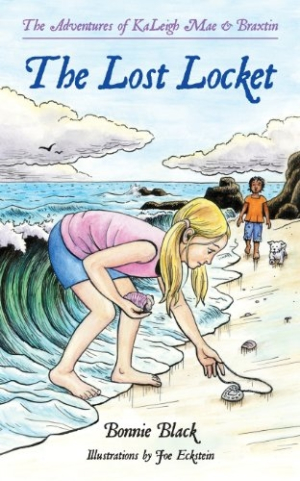The Lost Locket
An engaging book for younger readers, filled with enriching details.
Kids will find The Lost Locket, by Bonnie Black, an easy, fun read with a bit of a surprise at the climax. Serious themes range from experiencing grief (over the death of a parent) to rescuing a kidnapping victim, but the story isn’t too heavy for young readers to enjoy. Normative elements are combined with fantasy—such as the appearance of a second mother figure—to make the life of the protagonist far less sad while still introducing healthy grief into the narrative.
When little KaLeigh Mae discovers a mysterious locket containing a four-leaf clover and a picture of a woman who looks like her mother, she decides to keep it. Thus begins a set of dangerous new troubles for the girl and her newest friend, Braxtin.
KaLeigh Mae is the clever, resourceful protagonist of The Lost Locket (the first book in a planned series). She is pursued on several occasions by a shadowy man who inexplicably tries to steal the locket she found on the beach. Braxtin, an agreeable new friend, is an ancillary character who gives KaLeigh Mae someone to talk with and who helps facilitate KaLeigh Mae’s clever solutions. The girls do face danger, but the story is tempered with a villain who is less than nightmare-worthy, although he is sufficiently menacing.
A responsible young girl, KaLeigh Mae is also adventurous and sometimes acts without thinking. Her mother, idealized throughout the story, has recently died, and her father is engaged in her upbringing but is also distant and less than understanding about KaLeigh Mae’s needs. This characterization of the father is written into the action. For example, he goes to the police station, but only after his daughter has told him multiple times about the man who has been following her. Surprisingly, KaLeigh Mae and Braxtin are walking on the beach and breaking into a boarded-up house the next morning. Such flaws in the father’s ability to effectively negotiate the responsibility of single parenthood realistically depict what might happen after the sudden death of a spouse.
The author includes interesting, enriching details that can edify young readers. The girls discuss a scene from Steinbeck’s Cannery Row when they take a day-trip to Monterrey (the locale of Steinbeck’s book). Also, KaLeigh Mae, whose career goal is to “work with computers,” helps rescue a kidnapped computer-chip inventor. To follow the story’s plot twist requires a basic understanding of Moore’s Law, which the author sufficiently explains.
Awkward syntax, run-on sentences, and improper punctuation (especially a lack of commas) make the text difficult to read at times. For example, Black writes, “She reached for the locket around her neck and froze as she remembered that Officer Franklin had the locket at the police station and she is terrified to tell this man the truth.” There are also numerous grammatical errors (e.g., the use of “in which” for “in whom,” as well as issues concerning subject-verb agreement).
The story, covering a week of action, is told in a short fifty-five pages (including four full-page illustrations), yet it is seemingly meant for middle readers. At times, sentences are sketches of what could have been a more fleshed-out story. The resolution portion is too short and rushed.
The Lost Locket is often engaging and well-thought-out. This author has a burgeoning talent for creating scenes that readers will be able to visualize.
Reviewed by
Carrie Wallace
Disclosure: This article is not an endorsement, but a review. The publisher of this book provided free copies of the book and paid a small fee to have their book reviewed by a professional reviewer. Foreword Reviews and Clarion Reviews make no guarantee that the publisher will receive a positive review. Foreword Magazine, Inc. is disclosing this in accordance with the Federal Trade Commission’s 16 CFR, Part 255.


